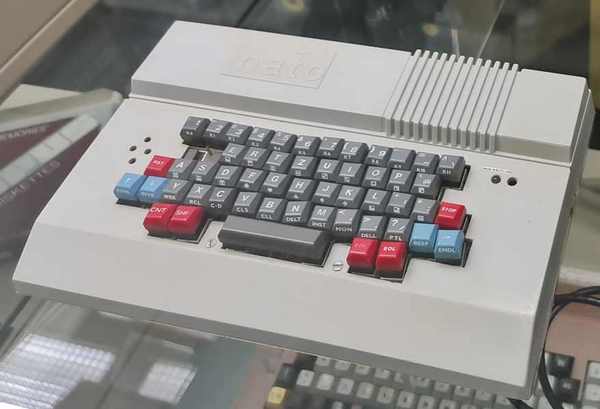Maťo
 Designed by Ivan Urda, Štefan Ševčík.It was manufactured from 1989 (Development 1987 in VÚZ STORSMALT Banská Bystrica) by Štátny majetok Závadka nad Hronom.
The computer was inspired by or was successor to BAPO. Hardware is based on MHB8080A @ 2,048 MHz, 48 KiB RAM, 16 KiB ROM.
Designed by Ivan Urda, Štefan Ševčík.It was manufactured from 1989 (Development 1987 in VÚZ STORSMALT Banská Bystrica) by Štátny majetok Závadka nad Hronom.
The computer was inspired by or was successor to BAPO. Hardware is based on MHB8080A @ 2,048 MHz, 48 KiB RAM, 16 KiB ROM.
PMD85 clone (PMD85.1 and PMD85.2) with minor modifications. The main goal of BAPO/MATO was to build a computer compatible with PMD 85, but cheaper and smaller.
Hardware
The whole computer is located on one plate of 271 x 120 mm. Another board contained a source including a network transformer.
- MHB processor 8080A @ 2.048 MHz
- RAM: 48 kb
- ROM: 16 kb
- Keyboard: 8x7 matrix with one omitted key (55 keys in total), board dimensions 245 x 115 mm
- Interface for standard cassette recorder
- resolution 288 × 256 pixels, monochromatically, TV output
Software
* System monitor and built-in Basic-G
The manufacturer has proposed an innovated design that allows the use of microcomputer in the local network, eg in the school classroom. This network supplied and assembled as a complete solution.
The development of the system, inspired by the Token Ring architecture, brought the following properties of the local network (LAN):
- Resident software that expands the monitor monitor commands for LAN support (read, send, set) and occupies only 2 KB of memory.
- A concentrator using a single -chip microcomputer MHB8748, allowing a connection of up to 31 satellite computers with equal access to the network.
- Possibility to connect a superior IBM-PC computer as a file server via a special card connected directly to the concentrator.
- Bit speed of 1200 bits per second with serial "handshake" protocol for each byte, using a 20 mA jet loop.
- The ability to transmit all types of data blocks and programs used by these types of microcomputers.
- Possibility of direct connection of two computers online without concentrator with software to transfer data in LAN.
- Easy implementation of technical (concentrator) and software resources on other types of computers.
- Structured LAN software provides basic services for user application programs.
The main network device is a 31-channel concentrator, designed for topology of the local Network type-Kruh, which allows on-line connections between two any network participants as follows:
- The concentrator checks the connection requirement using a circular sequence search (pooling). If it detects the transmission request (in = h), it reads the transmission header to determine the type of service and addressee number.
- Checks the sender number. If it does not match the actual number, it will repair it in the transmission header and send this modified header to the addressee.
- After handing over the transmission header to the addressee, it connects the path between the sender and the addressee and checks the communication between the participants using the passive interception.
- If there is no change in levels on line IN (= l) in 2 seconds, it will announce the transmission for the end and continues to search at the following address.
It is necessary to mention the internal service of the concentrator, which is provided on the basis of the READ 00G order - the applicant will receive from the concentrator status of the network participants.
As regards the technical solution of the concentrator, it is based on a single -chip microcomputer MHB8748. The participants are connected by two MH74150 multiplexers and two MH74154 demultiplexers, along with other support circuits. The block diagram of the concentrator and the specific connection of one two -way channel of the participant's current loop are shown in the attached figure.
In terms of communication between the concentrator and the participant, the concentrator has an internal address 00, which determines the number of participation channels. It follows that all participants have the same priority. For a superior computer it is necessary to use the 1F channel!